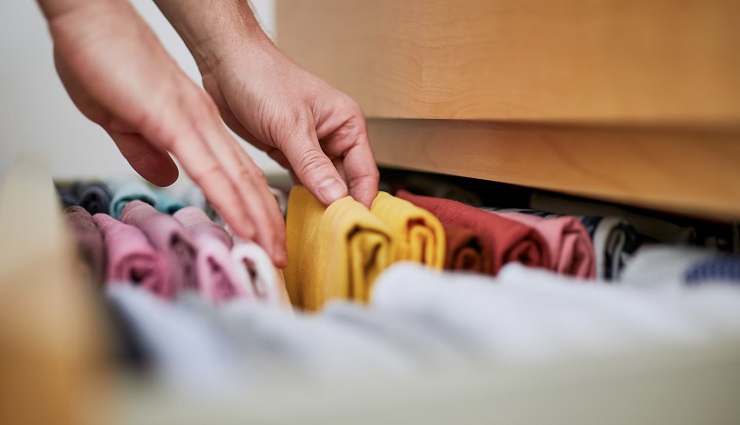Living in a small apartment without a bright space is not a good reason to say goodbye to apartment flowers! Some of these flowers, like the Aglaonema plant, are shade-loving houseplants, grow tall, and amaze you even in the lowest possible light. Join us to learn about the garlic to the onion of this popular ornamental flower.
Introduction of Aglaonema plant
Aglaonema, or “Chinese Evergreen,” is a genus of resistant houseplants that consists of 22 species and hundreds of different types. Their distinguishing feature is the color and design of the leaves. This tropical perennial plant is native to Southeast Asia and belongs to the Araceae family. It grows vertically and can grow up to 120 cm.
Aglaonema grows slowly and has dense foliage. The oval, pointed, elongated and downward-curving leaves bloom in spring or summer. If the maintenance conditions are suitable, this flower maintains its attractiveness all year round and remains evergreen.
Can we tell a little about the harms of aglaonema flowers? Be careful not to let your pet chew the leaves of this plant! This flower is attractive to dogs and cats, just like poison.
Care of the Aglaonema plant
If you are looking for a low-labor houseplant, we recommend Aglaonema. As long as this evergreen plant receives proper light, balanced soil, sufficient water, proper temperature and humidity, and periodic fertilizer, it proliferates, flowers, and beautifies the home.
1. Adequate light for Aglaonema
Species with dark green leaves grow well in the shade, and multi-colored species need more light. Just be careful not to expose any species of this plant to direct sunlight. Direct radiation quickly burns and destroys the leaves of Aglaonema.
2. The soil is suitable for Aglaonema
Aglaonema is not very sensitive to dirt. But both the earth and the pot must pass water easily. Cover the bottom of the pot with clay or pebbles, add a layer of high-quality potting soil, and do not compact the surface to allow air to circulate in the ground. Plant the plant and fill it with soil. You can add some perlite or sand to the potting mix for better drainage.
3. Irrigation of Aglaonema
Aglaonema likes moist soil but hates waterlogging. During the spring, summer, and autumn seasons, allow the soil surface to be semi-dry between each watering and increase this distance a little more in the winter. But never let the soil in the pot remain completely dry and thirsty.
4. Aglaonema storage temperature
Aglaonema loves heat very much. Move the pot away from the door and window and place it in a warm place. Do not let the ambient temperature fall below 18 degrees Celsius in winter. Keep the temperature between 20 and 25 degrees Celsius in the summer.
5. Aglaonema’s required humidity
Many consider Aglaonema a greenhouse plant because of its extreme love of moisture. If you want to see the remarkable growth of this flower, consider a humid place like the kitchen or near the bathroom. This interest is so great that if you live in dry areas of the country, you should consider getting a humidifier. Aglaonema loves dusting!
6. Fertilizer suitable for Aglaonema
The best way to fertilize this evergreen plant is twice a year, at the beginning and end of the growing season. Choose an appropriate houseplant fertilizer that strengthens the roots and leaves simultaneously and provides all the necessary nutrients to the plant.
Types of Aglaonema
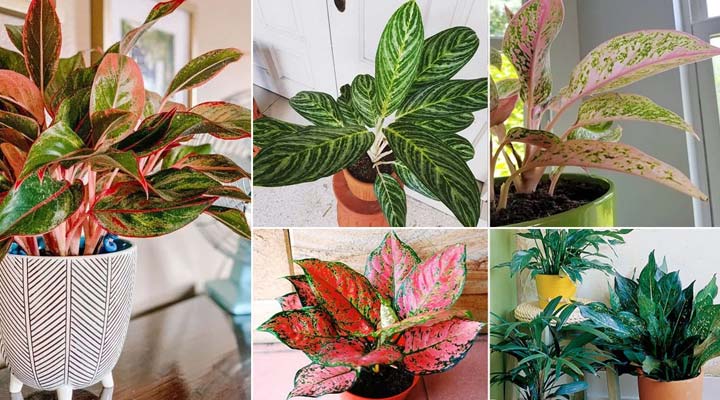
1. Red Aglaonema
The red Aglaonema with leaves 20 cm long and 10 cm wide bent downwards is one of the most attractive houseplants for indoor and office spaces. The short stems of this variety proliferate and host beautiful glossy red leaves with pink or bright red spots and veins.
2. Aglaonema cutlass
This beautiful flower is also known as aglaonema commie. This name is because of this plant’s long, veined, and dagger-like leaves. The color of the leaves of this species is an exciting combination of green, white, and cream. The edge of each leaf is also beautifully decorated with dark green.
3. Snowy Aglaonema
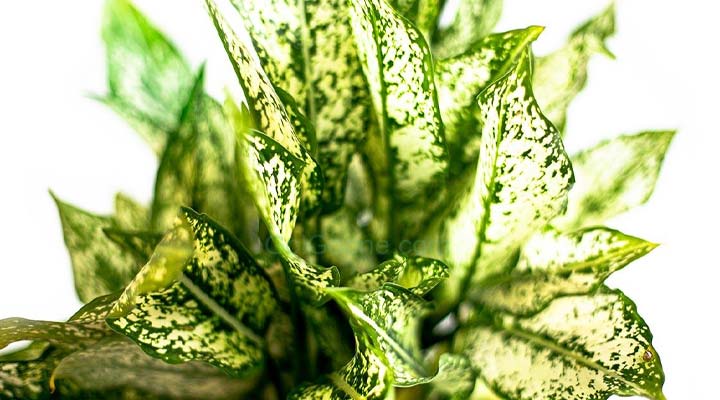
Look at this photo of an Aglaonema flower. Aglaonema black, or snow white, is one of the most popular species of this ornamental plant. Of course, despite its countless fans, it is rarely found in flower shops. This species with white leaves and a green border proliferates; the more light the environment has, the better it grows.
4. Aglaonema Sozi
Aglaonema Suzi is another popular species of this plant that, despite its bright color, loves the shade and grows better in low light.
5. Aglaonema Pattaya
You may know this species by name, such as silver Aglaonema or watermelon. This species is one of the most beautiful types of this shade-loving plant, whose broad and long leaves are very similar to Dieffenbachia.
6. Aglaonema Black
It is named Black because it has lanceolate and shiny dark green leaves and loves the dark. The excellent resistance of this species in low-light environments makes it a good choice for office and residential spaces.
Some other common species of this evergreen plant are:
- ‘Frasher’: This variety has milky green leaves, cream veins, and white petioles.
- “Pseudobracteatum”: On the veins of the leaves of this species, prominent gray-green spots can be seen.
- “White Rajah”: The leaves of this species are primarily white.
- “Red Zircon”: This aglaonema flower is characterized by green leaves with pink spots.
- “Silver Bay”: A species that owes its beauty to its silvery green leaves.
- ‘Maria’: A low light tolerant variety with dark green leaves and silvery stripes.
Aglaonema propagation methods
1. Propagation by stem cuttings
Cuttings are the easiest propagation method of agendas. Cuttings must be separated from the mother plant in spring. Take a sharp knife, disinfect it, and cut a 10cm stem from the main plant. Remove the end leaves of the cutting and plant them in a pot full of suitable soil. Of course, you can leave each cutting in water for a few weeks to take root and then transfer it to moist soil. For a better result, put a plastic bag over the pot to keep the humidity completely; remove the plastic now and then and let the plant breathe.
2. Propagation by dividing the plant
To propagate by root division, loosen the sides of the pot with a shovel and take the plant out of the pool along with the soil. Shake the root-soil and carefully remove it. Then slowly cut a part of the root and plant it in another pot. Keep both plants moist for a few weeks to be well-established in the soil and overcome the stress of the propagation process.
Common pests and diseases
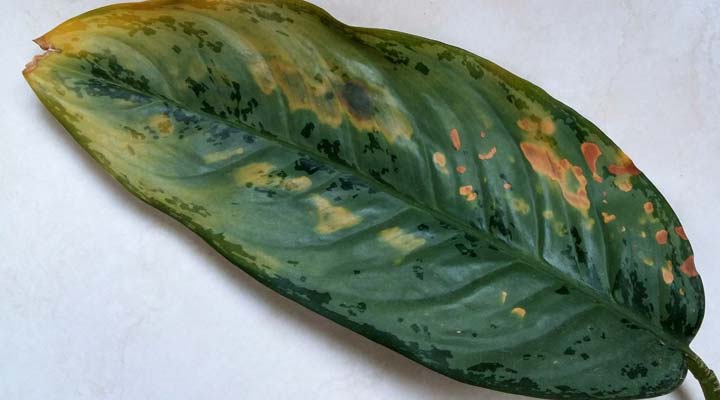
Fortunately, this beautiful flower is not very vulnerable to pests and diseases. But common pests of houseplants, such as scales, mealybugs, or spider mites, can damage this evergreen plant. Remember that this flower’s problems, such as fungal problems and root rot, are caused by excessive watering.
Common problems of Aglaonema
This resistant plant has a big problem, the curling of the leaves. To prevent this unpleasant event, apart from the pests and diseases in the previous section, be careful of these factors:
- Aging: Curling of the leaves of an old Aglaonema is an entirely everyday occurrence. Remove affected leaves.
- Too much light: Direct sunlight will burn the beautiful leaves of Aglonema. Remove the boiled leaves and change the place of the pot.
- Temperature changes: Aglaonema does not tolerate cold weather and changes its shape quickly in weather that is not warm enough.
- Low humidity: Sometimes, the curling of the leaves is a sign of the lack of moisture in flower.
- Low watering: thirsty soil damages the leaves of the plant and causes them to fall. Gently remove the dried leaves and water the flower.
- Excessive watering: this plant prefers dry soil to waterlogged soil. If too much watering causes the plant’s roots to rot, we will see the leaves of this plant turn yellow.
The flowering of the Aglaonema plant
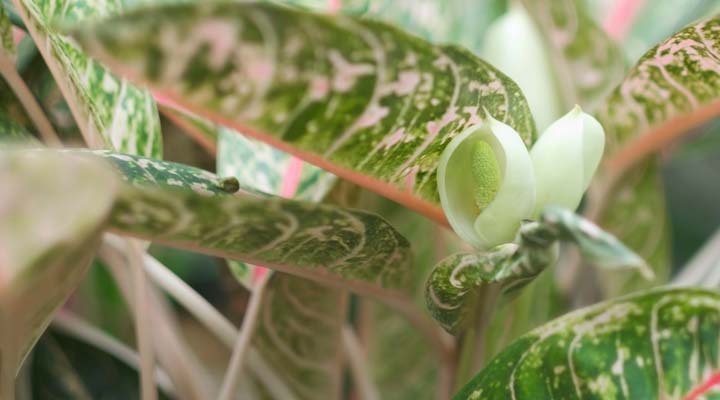
Would you like your plant to flower and enjoy picking Aglaonema flowers? Adjust the ambient light before doing anything. A lot of indirect light! No further effort is required. Little by little, spoon flower-like blossoms grow, which at first look like leaves but soon open and double the beauty of the flower.
Common questions
1. Is it hard or easy to maintain Aglaonema?
Aglaonema is one of the least demanding houseplants. This shade-loving plant can be kept in almost any closed space and grows best with low light, high temperature and humidity, balanced irrigation, and periodic fertilization.
2. What is the difference between Aglaonema and Dieffenbachia?
Although the leaves of these two plants are quite similar, the silver color on the leaves of Aglaonema and the larger size of the leaves of Dieffenbachia distinguish these two plants from each other.
3. How fast does Aglaonema grow?
The growth rate of this house flower is slow. Changing the pot after 2 to 3 years of planting may not be necessary.
4. Does aglonema flower?
Yes, June to September is the flowering season of Aglaonemas. Spike-like flowers that turn into red berries when pollinated.
you say
How much do you know about Aglaonema? Do you have experience in maintaining this perennial ornamental plant? We are eager to hear your knowledge and experiences about this beautiful tropical flower.

